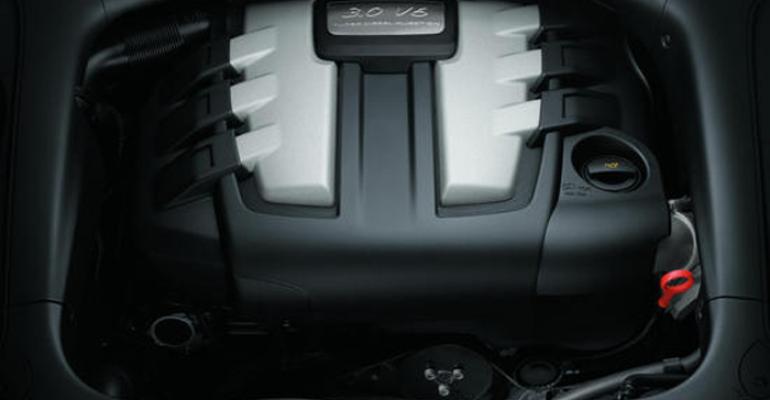A hot-seller in Europe where it accounts for 65%-70% of sales, a diesel-powered Porsche Cayenne will hit the U.S. market in September.
The $55,750 model will boast the next-generation, more fuel-efficient version of the V-6 diesel already available in the U.S. in the VW Toureg and Audi Q7. Porsche says the revamped engine is mated to an 8-speed automatic geared with performance in mind, helping to differentiate it from the lower-priced Toureg.
“We have a special setup for our transmission, and we have different shifting points than the Touareg or Q7,” Stefan Fegg, project manager for SUV powertains at Porsche, tells WardsAuto.
In the U.S., the diesel variants of the ’12 Touareg and ’12 Q7 start at $46,875 and $51,450, respectively.
The second-generation engine makes 240 hp in the Cayenne, compared with the 225 hp for the original turbodiesel in the ’12 Touareg and Q7. The revamped powerplant is expected to migrate to the VW and Audi models at some point, as well.
The Cayenne diesel burns 10% less fuel than the first-gen engine and meets Tier 2 Bin 5 U.S. emissions standards via an oxidation catalyst, diesel particulate filter and a selective catalytic reduction system using AdBlue, VW’s urea additive.
The new engine also boasts a cooled exhaust-gas-recirculation system, which Fegg says can send up to 60% of exhaust back to the engine.
New piezo fuel injectors are able to inject six times the fuel per working cycle.
Other features of the updated 3.0L turbodiesel include a block made of compacted graphite iron that is about 55 lbs. (25 kg) lighter than a conventional iron block; new cylinder heads; a Garrett variable-vane-geometry turbocharger; and a pre-fill system that heats to 1,832° F (1,000° C) in two seconds, Fegg says.
The new mill’s horsepower peak is reached between 3,500-4,000 rpm, and maximum torque of 406 lb.-ft. (550 Nm), the same as for the first-gen turbodiesel in the Touareg/Q7, arrives at as low as 1,750 rpm.
Porsche estimates fuel economy at 20/28 mpg city/highway (11.8/8.4 L/100 km), or 23 mpg (10.2 L/100 km) combined, and says the Cayenne Diesel can travel 740 miles (1,191 km) between fill-ups. The ’12 Touareg has a combined fuel economy of 22 mpg (10.7 L/100 km), while the ’12 Q7 averages 20 mpg.
The Cayenne Diesel hits the estimated fuel-economy figures without the benefit of a stop/start system, which is available on other Cayenne models.
Fegg says two concerns prevented Porsche from mating stop/start with the diesel: A fear of how the technology would impact Porsche’s scores in third-party quality and reliability surveys, and the temperature drops that would occur in the exhaust system.
“If you stop the engine, you lose a lot of temperature in the exhaust system, and then you need another time to relax the exhaust system and to fulfill your emissions level,” he says.
While Porsche expects 10%-15% of Cayenne buyers in the U.S. to opt for the diesel, Audi and BMW have seen diesel take rates as high as 30%-40%.
Fegg is non-committal as to whether the Cayenne Diesel could achieve similar take rates but touts the engine as the “most modern” in the industry and one that will go a long way to change negative perceptions about diesels.
“I think we have a big chance to bring the diesel to the U.S. market and find new customers for that,” he says. “The times where diesel cars were filthy or loud or had vibration are gone.”





